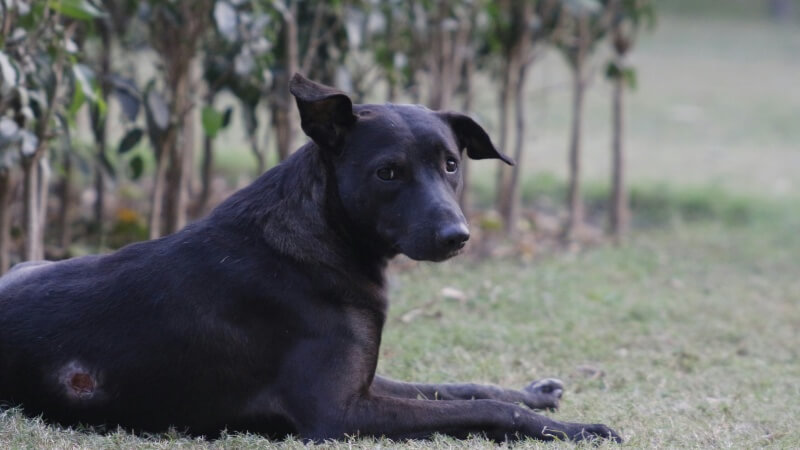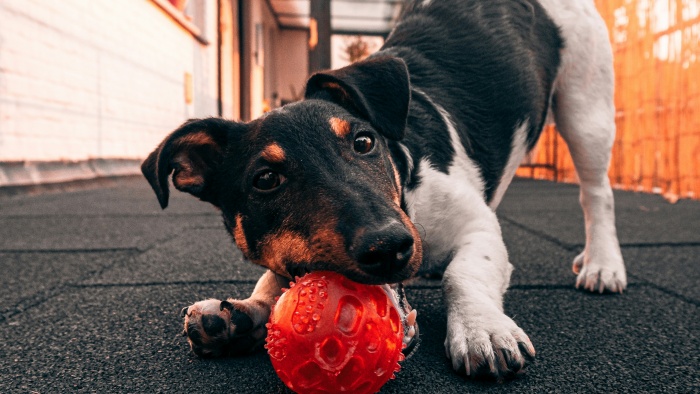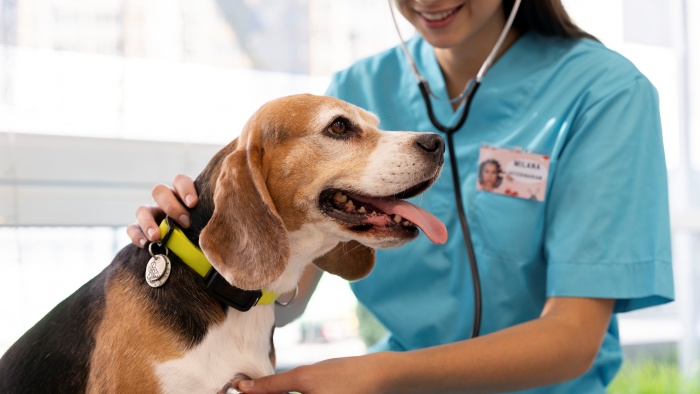Dogs Licking Wounds:How To Prevent It?

Dogs licking wounds is a common sight, especially when they roam freely, engaging in playful activities like fetch without a care in the world. Their inherent agility notwithstanding, they occasionally misjudge their movements, leading to trips and falls. The freedom they enjoy, mingling with other canines and exploring streets, exposes them to various risks of injuries and wounds.
Upon sustaining an injury or after undergoing surgery, dogs naturally tend to tend to the affected spot by licking it. However, encouraging this instinctual behavior is not beneficial for your pet’s health.
Although dog saliva has certain properties that may aid in cleaning wounds to a minor extent, it’s more probable that their licking will introduce contaminants rather than promote healing. Persistent licking or biting at their injuries can lead to infections, further complicating their health situation.
Licking wounds serves as a grooming reflex for dogs, but it’s crucial to remember that a dog’s mouth harbors numerous bacteria, which can be harmful as well as beneficial. To prevent complications, veterinarians often recommend the use of E-collars or protective sleeves for dogs recovering from surgery, thereby stopping them from licking, scratching, or biting their wounds.
Always consult a veterinarian if your pet suffers from a severe wound. Relying solely on the protective measures mentioned here without professional advice is not advised for managing your pet’s health issues.
How to keep my dog from licking a wound
Keeping your dog from licking its wound is crucial for its recovery, regardless of the wound’s severity. While certain products might be effective for some pets, no single solution fits all. Some dogs may require multiple strategies to comfortably prevent them from licking their wounds. Here are several methods to deter your dog from licking its injuries.
Cover the wound
Upon your veterinarian’s advice, consider using recovery bodysuits, sleeves, or socks to protect your dog’s stitches. To keep these coverings in place, use medical tape, but ensure it doesn’t directly touch the skin to avoid pulling on your pet’s fur.
Give your dog something to chew on
Distract your dog from its wound by providing chewable toys like rubber balls. If your pet is supposed to stay in a confined space, monitor its interaction with the toys to avoid excessive roughness.

Engage your dog with different activities or treats that require following commands, which helps in diverting its attention from the wound and reduces the urge to scratch.
Teach tricks and offer treats as tasty rewards
Avoid physical strain on your dog post-surgery by substituting active games with mental stimulation, such as clicker training. Reward your pet with delicious treats for successfully learning and performing new tricks, which not only keeps its mind off the wound but also promotes a positive recovery environment.
Accessories to help prevent wound licking
To prevent your dog from getting to its wounds, dressing it in suitable garments and accessories can effectively shield the area. Options like compression sleeves, collars, or onesies are excellent for keeping your dog from licking off medicinal creams, nibbling at the wound, or removing any dressings from a surgery site.
Ensuring the correct size for your dog is crucial for the fit of any protective wear or collar to be perfect. It’s important that whatever you choose allows your dog the freedom to move comfortably. Additionally, consider the wound’s location to select an accessory that adequately prevents your dog from reaching and aggravating the injury.
Below are some accessories to consider for covering your dog’s wound:
Leg sleeve
For wounds or surgical sites on your dog’s limbs, leg sleeves or compression sleeves, made from breathable materials, offer focused protection.
Unlike full-body suits, these sleeves target specific areas, ensuring your dog retains mobility while the wound remains protected from licking, scratching, and external pollutants.
Lick Sleeve offers top-notch options for both front and hind limb protection, worth checking for a snug fit.
Elizabethan collar (e-collar)
The E-collar, a traditional plastic cone, is widely used for pet recovery. Its fabric variants provide a softer, more pliable alternative, enhancing comfort for your pet.
Though E-collars are commonly prescribed post-operation, they can distress your pet, leading to accidental bumps into household items. Training your dog to navigate its surroundings while wearing an E-collar, especially in confined spaces, can ease this transition.
Inflatable collar
For a less cumbersome option, consider an inflatable collar. These collars are lightweight and don’t hinder your pet’s comfort as much as traditional cones.

Neck brace collar
For neck injuries, a neck brace collar offers support by limiting excessive movement. Properly adjusted, it allows for side-to-side head movement without compromising the healing process, particularly important for dogs recovering from neck surgery.
Protective bandages and dog boots
To protect wounds on the feet, veterinarians might recommend bandages or boots to prevent dirt and other contaminants from compromising the healing area. Gauze and vet-wrap are ideal for easy application and removal.
Dog boots can extend protection, keeping the lower leg area clean and dry, while also offering indoor traction and shielding from harsh outdoor elements.
Recovery suits or post-surgical garments
For full-body coverage, recovery suits are a comfortable, durable choice made from cotton. Unlike collars, these suits use Velcro tabs for easy adjustment and coverage, including the area behind the ears, offering an all-encompassing solution to wound protection.
Ensure a smooth recovery for your dog
It’s a natural instinct for dogs to lick their wounds as a response to the discomfort of injuries. However, too much licking can lead to irritation and infection of the wound and adjacent areas.

Your veterinarian will provide a comprehensive treatment plan, and following through with the prescribed aftercare is crucial.
Proper aftercare prevents additional complications, facilitating a smoother and more effective recovery process for your dog.
Conclusion
Dogs licking wounds is a behavior rooted in their instinct to soothe discomfort from injuries. However, this natural response can hinder the healing process, leading to further complications.
By adopting a proactive approach that includes consulting with a veterinarian, employing protective accessories, and engaging your dog in alternative activities, you can ensure a safer and quicker recovery for your pet.
Through understanding and mitigating the risks associated with wound licking, pet owners can provide the best possible care, helping their canine companions to heal without additional harm.
FAQs
What should I do if my dog continues to try and lick its wound despite wearing a protective garment?
If your dog persistently attempts to lick its wound through the garment, consider additional strategies such as more secure fitting of the garment, using a combination of protective devices (e.g., combining a leg sleeve with an E-collar), or introducing more distractions like engaging toys or training exercises. Consultation with your vet may also provide alternative solutions tailored to your dog’s behavior.
Can I use human bandages or garments as a substitute for specialized dog recovery accessories?
While it may be tempting to use human bandages or garments as a makeshift solution, they may not provide the same level of protection or comfort as products designed specifically for dogs. Human products might not fit properly, could restrict movement, or fail to cover the wound adequately. Always opt for vet-recommended products designed for canine anatomy and needs.
How can I ensure the protective accessory doesn’t cause additional discomfort or stress to my dog?
To minimize discomfort or stress, ensure the protective accessory fits correctly without being too tight or loose. Introduce the accessory gradually, allowing your dog to get accustomed to it in a calm and positive manner. Regularly check for any signs of irritation or discomfort around the accessory’s edges and consult your vet if you have concerns about your dog’s stress levels or comfort.
Is it necessary to monitor my dog’s wound if it’s covered with a protective accessory?
Yes, regular monitoring of your dog’s wound is essential, even when it’s covered. Check the wound at least once a day for signs of infection, proper healing, and to ensure the bandages or protective accessories are clean and dry. This allows you to catch any potential issues early and adjust care as needed.
What signs of infection should I look out for in my dog’s wound?
Be vigilant for signs of infection such as increased redness, swelling, warmth, unpleasant odor, discharge, or if your dog seems to be in pain or discomfort when the area is touched. If your dog’s wound exhibits any of these symptoms, it’s crucial to contact your veterinarian immediately for advice and potential treatment adjustments.

